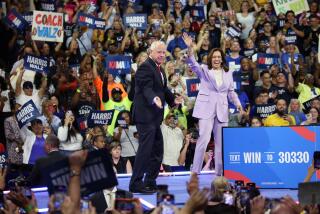Reclaim the High Ground of the ‘60s
- Share via
As the Democratic Party convenes in Chicago for the first time since its debacle there in 1968, a cataclysm from which the party did not recover for more than two decades (if, indeed, it has done so yet), it is an appropriate time to examine the relationship between the 1960s and American politics today.
The ‘60s defined liberalism and conservatism for the remainder of the century. By linking the former with antiwar protest, minority rights movements, violence and licentiousness, the decade set the stage for the decline of liberalism, leaving a void that the brand of conservatism that emerged in the ‘60s was gradually able to fill over the following quarter of a century.
It is essential to understand that there were two ‘60s. The ‘60s that still merit our homage, the “good ‘60s,” ran from the civil rights sit-ins that began in February 1960 through the middle years of the decade, and centered on optimism, integration, sacrifice, devotion to community and confidence in the capacity of government to play a role in making people’s lives better. What is more often remembered today and what is properly denounced by conservatives is the “bad ‘60s,” which ran from about 1967 through the early 1970s, and centered on hedonism, excessive individual freedom, pessimism, disintegration and separatism, and the conclusion that government was inept, corrupt and evil. These two ‘60s have become almost inextricably intertwined in the public mind, but separating them is essential to the future well-being of both the Democratic Party and the nation.
Both ‘60s were represented at Chicago 28 years ago, but that Democratic convention can with considerable accuracy be seen as the funeral of the good ‘60s (and the placing of the Democratic Party in a sort of near-death suspended animation) and the inaugural of the bad ‘60s (particularly in the actions of the “yippies”).
A major reason for the Democrats’ failure to win more than two presidential elections of the seven since 1968 is the Republicans’ skill in identifying Democrats with the bad ‘60s. This effort has enjoyed great assistance from Democratic liberals, many of whom slid from their support for the good ‘60s into needlessly tying themselves to the excesses of the bad. Since the Republicans were not associated with either of the ‘60s, they have been able to market themselves as what amounts to the anti-’60s party. They have done a good job of persuading a large number of Americans that the country was nearly perfect before the ‘60s, when it was wrecked by Democrats, liberals, hippies and their fellow travelers (including, although this is usually not said explicitly, blacks and women).
The wide philosophical divide within what was often spoken of in the singular as “the movement” was evident in the social-political side’s early emphasis on civil rights and the cultural radicals’ insistence on individual rights. The implications of these two adjectives are strikingly different. “Civil rights” implies rights as citizens, which carry obligations to the community; they are rights bound up with responsibilities, the rights of people who are situated--members of a community--not free-floating “selves.” Civil rights are entirely compatible with traditional values; indeed they are rooted in those values. But individual rights imply no necessary connection with anyone else, and so no responsibilities. This idea matches the “every man for himself” doctrine of the modern, consumption-based economy. Individual rights carried to an extreme subvert traditional values.
The great irony that has generally escaped notice is that the “conservative” social and economic philosophy of the right-wing, libertarian Republicans is actually closer to the outlook of the late bad ‘60s than that of liberal Democrats. Conservatives, after all, have nothing against self-centeredness or excess, at least when it comes to the accumulation of wealth. The counterculture is kin to the counting culture, as the biographies of such yippies-turned-yuppies as Jerry Rubin suggest.
The Democrats will have an opportunity in Chicago this week to complete their escape from the comatose condition that their last Chicago convention left them in. All they have to do is firmly identify themselves with the good ‘60s while demonstrating to voters the parallels between the Republicans’ belief in an unfettered economy and the self-indulgent society that is a legacy of the bad ‘60s, and the Democrats’ resuscitation will be complete.
More to Read
Get the L.A. Times Politics newsletter
Deeply reported insights into legislation, politics and policy from Sacramento, Washington and beyond. In your inbox three times per week.
You may occasionally receive promotional content from the Los Angeles Times.










